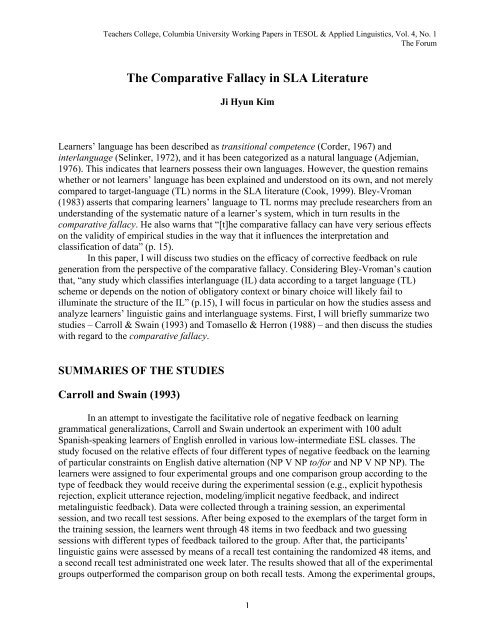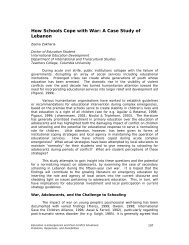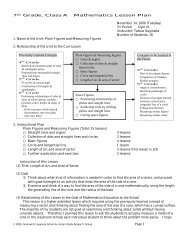The Comparative Fallacy in SLA Literature - Teachers College ...
The Comparative Fallacy in SLA Literature - Teachers College ...
The Comparative Fallacy in SLA Literature - Teachers College ...
Create successful ePaper yourself
Turn your PDF publications into a flip-book with our unique Google optimized e-Paper software.
<strong>Teachers</strong> <strong>College</strong>, Columbia University Work<strong>in</strong>g Papers <strong>in</strong> TESOL & Applied L<strong>in</strong>guistics, Vol. 4, No. 1<br />
<strong>The</strong> Forum<br />
<strong>The</strong> <strong>Comparative</strong> <strong>Fallacy</strong> <strong>in</strong> <strong>SLA</strong> <strong>Literature</strong><br />
Ji Hyun Kim<br />
Learners’ language has been described as transitional competence (Corder, 1967) and<br />
<strong>in</strong>terlanguage (Sel<strong>in</strong>ker, 1972), and it has been categorized as a natural language (Adjemian,<br />
1976). This <strong>in</strong>dicates that learners possess their own languages. However, the question rema<strong>in</strong>s<br />
whether or not learners’ language has been expla<strong>in</strong>ed and understood on its own, and not merely<br />
compared to target-language (TL) norms <strong>in</strong> the <strong>SLA</strong> literature (Cook, 1999). Bley-Vroman<br />
(1983) asserts that compar<strong>in</strong>g learners’ language to TL norms may preclude researchers from an<br />
understand<strong>in</strong>g of the systematic nature of a learner’s system, which <strong>in</strong> turn results <strong>in</strong> the<br />
comparative fallacy. He also warns that “[t]he comparative fallacy can have very serious effects<br />
on the validity of empirical studies <strong>in</strong> the way that it <strong>in</strong>fluences the <strong>in</strong>terpretation and<br />
classification of data” (p. 15).<br />
In this paper, I will discuss two studies on the efficacy of corrective feedback on rule<br />
generation from the perspective of the comparative fallacy. Consider<strong>in</strong>g Bley-Vroman’s caution<br />
that, “any study which classifies <strong>in</strong>terlanguage (IL) data accord<strong>in</strong>g to a target language (TL)<br />
scheme or depends on the notion of obligatory context or b<strong>in</strong>ary choice will likely fail to<br />
illum<strong>in</strong>ate the structure of the IL” (p.15), I will focus <strong>in</strong> particular on how the studies assess and<br />
analyze learners’ l<strong>in</strong>guistic ga<strong>in</strong>s and <strong>in</strong>terlanguage systems. First, I will briefly summarize two<br />
studies – Carroll & Swa<strong>in</strong> (1993) and Tomasello & Herron (1988) – and then discuss the studies<br />
with regard to the comparative fallacy.<br />
SUMMARIES OF THE STUDIES<br />
Carroll and Swa<strong>in</strong> (1993)<br />
In an attempt to <strong>in</strong>vestigate the facilitative role of negative feedback on learn<strong>in</strong>g<br />
grammatical generalizations, Carroll and Swa<strong>in</strong> undertook an experiment with 100 adult<br />
Spanish-speak<strong>in</strong>g learners of English enrolled <strong>in</strong> various low-<strong>in</strong>termediate ESL classes. <strong>The</strong><br />
study focused on the relative effects of four different types of negative feedback on the learn<strong>in</strong>g<br />
of particular constra<strong>in</strong>ts on English dative alternation (NP V NP to/for and NP V NP NP). <strong>The</strong><br />
learners were assigned to four experimental groups and one comparison group accord<strong>in</strong>g to the<br />
type of feedback they would receive dur<strong>in</strong>g the experimental session (e.g., explicit hypothesis<br />
rejection, explicit utterance rejection, model<strong>in</strong>g/implicit negative feedback, and <strong>in</strong>direct<br />
metal<strong>in</strong>guistic feedback). Data were collected through a tra<strong>in</strong><strong>in</strong>g session, an experimental<br />
session, and two recall test sessions. After be<strong>in</strong>g exposed to the exemplars of the target form <strong>in</strong><br />
the tra<strong>in</strong><strong>in</strong>g session, the learners went through 48 items <strong>in</strong> two feedback and two guess<strong>in</strong>g<br />
sessions with different types of feedback tailored to the group. After that, the participants’<br />
l<strong>in</strong>guistic ga<strong>in</strong>s were assessed by means of a recall test conta<strong>in</strong><strong>in</strong>g the randomized 48 items, and<br />
a second recall test adm<strong>in</strong>istrated one week later. <strong>The</strong> results showed that all of the experimental<br />
groups outperformed the comparison group on both recall tests. Among the experimental groups,<br />
1
<strong>Teachers</strong> <strong>College</strong>, Columbia University Work<strong>in</strong>g Papers <strong>in</strong> TESOL & Applied L<strong>in</strong>guistics, Vol. 4, No. 1<br />
<strong>The</strong> Forum<br />
the explicit hypothesis rejection group, which received the most explicit feedback, performed<br />
considerably better than the other feedback groups.<br />
Tomasello & Herron (1988)<br />
This study aimed to explore the relative effects of two methods for teach<strong>in</strong>g exceptions to<br />
grammatical rules: correction of <strong>in</strong>duced errors <strong>in</strong> Garden Path sentences, and explicit teach<strong>in</strong>g<br />
of exceptions to grammatical rules. Thirty-n<strong>in</strong>e college students enrolled <strong>in</strong> two sections of<br />
beg<strong>in</strong>n<strong>in</strong>g-level French classes participated. <strong>The</strong>y were randomly assigned to two groups. Each<br />
group received one teach<strong>in</strong>g method (Garden Path or explicit teach<strong>in</strong>g) for one semester, and<br />
then received the other teach<strong>in</strong>g method the follow<strong>in</strong>g semester. Eight target structures known as<br />
“exceptions to a rule” were randomly assigned to the two teach<strong>in</strong>g conditions. <strong>The</strong> students <strong>in</strong><br />
the Garden Path group received canonical exemplars and were encouraged to <strong>in</strong>duce the rule.<br />
After that, the students were presented with the exceptions to the rule, without be<strong>in</strong>g told that<br />
these were exceptions. In this process, the students were <strong>in</strong>duced to make errors, and the<br />
teachers immediately corrected the result<strong>in</strong>g overgeneralization errors. In the explicit rule<br />
presentation group, the students were explicitly taught the exception as an exception and<br />
expected to memorize the rules. <strong>The</strong> results of posttests <strong>in</strong>dicated that the students learned the<br />
exceptions better <strong>in</strong> the Garden Path condition, and such learn<strong>in</strong>g was ma<strong>in</strong>ta<strong>in</strong>ed throughout the<br />
semester. <strong>The</strong> study revealed the positive impact of feedback on learn<strong>in</strong>g exceptions by prov<strong>in</strong>g<br />
the benefits of draw<strong>in</strong>g learners’ attention to the rule itself and the exception by provid<strong>in</strong>g<br />
feedback.<br />
DISCUSSION<br />
In this section, I will discuss (a) the limitation of employ<strong>in</strong>g a s<strong>in</strong>gle TL scheme to<br />
analyze the learners’ <strong>in</strong>ternal systems (Bley-Vroman, 1983), and (b) the problem with access<strong>in</strong>g<br />
multicompetent L2 users’ language norms us<strong>in</strong>g monol<strong>in</strong>gual speakers’ norms (Cook, 1999).<br />
Measurement<br />
Swa<strong>in</strong> and Carroll (1993) fell short of expla<strong>in</strong><strong>in</strong>g the learners’ <strong>in</strong>ternal systems on the<br />
target forms by solely measur<strong>in</strong>g the systems us<strong>in</strong>g a s<strong>in</strong>gle TL scheme (Bley-Vroman, 1983).<br />
<strong>The</strong> target language forms (of the English dative alternation) <strong>in</strong> the learners’ ILs were merely<br />
assessed by their ability to produce the target norms on two recall tests. <strong>The</strong> number of correct<br />
answers was simply counted to report the learners’ approximation to the target norm. More<br />
specifically, no further analysis on the learners’ performance with the alternat<strong>in</strong>g verbs followed.<br />
<strong>The</strong> learners may have determ<strong>in</strong>ed the possibility of alternation rely<strong>in</strong>g on the verb category they<br />
had established themselves through <strong>in</strong>put. Except for the learners <strong>in</strong> the explicit hypothesis<br />
rejection group, the rest of the learners were expected to set up the rules based on exemplars and<br />
the feedback they were provided. Explor<strong>in</strong>g the rule devised by the learners may reveal the<br />
learners’ learn<strong>in</strong>g problems on the generalization of the English dative alternation. Furthermore,<br />
the learners may have merely guessed the answers without bas<strong>in</strong>g them on any systematic rules.<br />
2
<strong>Teachers</strong> <strong>College</strong>, Columbia University Work<strong>in</strong>g Papers <strong>in</strong> TESOL & Applied L<strong>in</strong>guistics, Vol. 4, No. 1<br />
<strong>The</strong> Forum<br />
In this case, the score calculated would not reflect the learners’ <strong>in</strong>ternal logic regard<strong>in</strong>g<br />
generalization.<br />
Similarly, Tomasello and Herron (1988) overlooked the students’ <strong>in</strong>ternalization of the<br />
rules and the exceptional rules by merely measur<strong>in</strong>g their language through the use of fill-<strong>in</strong>-theblank<br />
tests. This assessment only allowed the researchers to test the learners’ declarative<br />
knowledge on certa<strong>in</strong> l<strong>in</strong>guistic features. In other words, what was tested was the learners’<br />
simple memorization of l<strong>in</strong>guistic rules, not the learners’ acquisition of target forms. <strong>The</strong><br />
feedback learners received <strong>in</strong> this study may have just re<strong>in</strong>forced their memorization of the<br />
exceptional rules. Assess<strong>in</strong>g scores of learner memorization of target norms cannot reflect<br />
learners’ <strong>in</strong>terlanguage systems.<br />
Also, by merely look<strong>in</strong>g at the test scores, it seems that the students successfully dealt<br />
with <strong>in</strong>tra-l<strong>in</strong>gual transfer – the students got almost perfect scores on tests of five out of eight<br />
forms. However, without assess<strong>in</strong>g the students’ application of the target form to other contexts,<br />
that is, their control over the forms, it is premature to conclude that their <strong>in</strong>ternal systems had<br />
effectively dealt with <strong>in</strong>tra-l<strong>in</strong>gual transfer.<br />
In addition, depend<strong>in</strong>g on the targeted l<strong>in</strong>guistic features, the students’ l<strong>in</strong>guistic ga<strong>in</strong>s<br />
exhibited variation. For <strong>in</strong>stance, while the students’ performance <strong>in</strong> the Garden Path group on<br />
the targeted forms Du and Au improved gradually through three tests, their performance on<br />
Meilleur, -er imperative and Cet showed backslid<strong>in</strong>g <strong>in</strong> the second test. In the control group,<br />
while the students showed gradual improvement on Cet, their test scores on Ne decreased. This<br />
<strong>in</strong>dicated that, although these rules are all exceptional rules <strong>in</strong> French, the students’ <strong>in</strong>ternal<br />
systems may not have sensed these rules at the same level.<br />
Multicompetent Language Users<br />
Cook (1999) describes second language (L2) users as multicompetent language users, and<br />
they “have the L1 constantly available to them” (p. 192) dur<strong>in</strong>g language process<strong>in</strong>g. He also<br />
po<strong>in</strong>ts out that multicompetent language users have language and thought processes different<br />
from those of monol<strong>in</strong>gual users. Thus, to understand learners’ <strong>in</strong>terlanguage, it is <strong>in</strong>dispensable<br />
to be aware of their first language (L1).<br />
Given this condition <strong>in</strong> both studies, the learners’ first language (L1) may have affected<br />
IL development to a considerable extent. Cook suggests that it may be more desirable to look at<br />
L2 users’ performance based not on the target norms, but on the norms of high level L2 users, <strong>in</strong><br />
order to ga<strong>in</strong> real <strong>in</strong>sight <strong>in</strong>to learners’ <strong>in</strong>ternal logic controlled by both the L1 and the L2.<br />
However, <strong>in</strong> both studies, the learners’ <strong>in</strong>terlanguage was merely assessed us<strong>in</strong>g the<br />
monol<strong>in</strong>guals’ target norms. Consequently, both studies fail to show how the learners’ L1 and<br />
prior knowledge of the L2 may have had an impact on the development of their <strong>in</strong>ternal<br />
<strong>in</strong>terlanguage systems.<br />
In sum, <strong>in</strong> both studies, the <strong>in</strong>dividual learners’ <strong>in</strong>terlanguage was merely measured by a<br />
s<strong>in</strong>gle TL scheme, and this may have eventually obscured not only the structure of the <strong>in</strong>dividual<br />
<strong>in</strong>terlanguage, but the structure of each <strong>in</strong>terlanguage <strong>in</strong> the population <strong>in</strong> a different way as well<br />
(Bley-Vroman, 1983). In addition, both studies fell short of reveal<strong>in</strong>g the learners’ <strong>in</strong>ternal<br />
systems built on both first and second language knowledge by judg<strong>in</strong>g multicompetent L2 users’<br />
language based on the monol<strong>in</strong>gual’s TL norms (Cook, 1999). Hence, although both studies lend<br />
3
<strong>Teachers</strong> <strong>College</strong>, Columbia University Work<strong>in</strong>g Papers <strong>in</strong> TESOL & Applied L<strong>in</strong>guistics, Vol. 4, No. 1<br />
<strong>The</strong> Forum<br />
some support to the role of corrective feedback on rule generation, they failed to f<strong>in</strong>d the<br />
learners’ underly<strong>in</strong>g <strong>in</strong>ternal systems restructured by the feedback. Consequently, the lack of<br />
understand<strong>in</strong>g of the learners’ <strong>in</strong>ternal systems may threaten the validity of these studies, as<br />
Bley-Vroman noted.<br />
CONCLUSION<br />
Empirical studies which merely count learners’ errors and then measure the learners’<br />
<strong>in</strong>terlanguage systems are likely to fall <strong>in</strong>to the comparative fallacy (Bley-Vroman, 1983).<br />
Unfortunately, a considerable amount of research on the efficacy of corrective feedback <strong>in</strong> L2<br />
development has been conducted <strong>in</strong> this manner, that is, the learners’ exhibited l<strong>in</strong>guistic ga<strong>in</strong>s<br />
have been assessed by a s<strong>in</strong>gle TL scheme (target-like or non-target-like utterances). This<br />
measurement is not <strong>in</strong>sightful enough to explore the learners’ developmental processes. If so,<br />
how can learners’ developmental processes be measured <strong>in</strong> studies on corrective feedback?<br />
Doughty and Varela (1998) provided one possible way to avoid the comparative fallacy. <strong>The</strong>y<br />
employed <strong>in</strong>terlanguage analysis which measures learners’ performance <strong>in</strong> three ways: (a)<br />
changes to target-like use, (b) changes that showed improvements while still fall<strong>in</strong>g short of the<br />
full target version, and (c) decl<strong>in</strong>es <strong>in</strong> non-target-like use. This measurement enabled the<br />
researchers to track the learners’ developmental processes caused by the provision of feedback.<br />
In order to assess learners’ <strong>in</strong>ternal systems and avoid the comparative fallacy, there is a need to<br />
develop sophisticated and <strong>in</strong>sightful measurement.<br />
Furthermore, it may be possible to discern some pedagogical implications here. In most<br />
cases, students’ errors are judged by the target norms teachers possess, and the teachers provide<br />
feedback to the students based on their judgment. If the students’ <strong>in</strong>ternal logic is not counted<br />
and the teachers’ provision of feedback solely relies on the teachers’ logic, this feedback can fall<br />
<strong>in</strong>to the comparative fallacy. This eventually br<strong>in</strong>gs about mismatches between the teachers’<br />
<strong>in</strong>tention and the students’ <strong>in</strong>terpretations, which can render corrective feedback <strong>in</strong>effective. It<br />
should be noted that teachers, as feedback providers, have to make an effort to adapt themselves<br />
to learners and look at their <strong>in</strong>ternal systems <strong>in</strong> order to use feedback to facilitate the learners’ IL<br />
development.<br />
REFERENCES<br />
Adjemian, C. (1976). On the nature of <strong>in</strong>terlanguage systems. Language Learn<strong>in</strong>g, 26,<br />
297-320.<br />
Bley-Vroman, R. (1983). <strong>The</strong> comparative fallacy <strong>in</strong> <strong>in</strong>terlanguage studies: <strong>The</strong> cast of<br />
systematicity. Language Learn<strong>in</strong>g, 33, 1-17.<br />
Carroll, S., & Swa<strong>in</strong>, M. (1993). Explicit and implicit negative feedback: An empirical study of<br />
the learn<strong>in</strong>g of l<strong>in</strong>guistic generalizations. Studies <strong>in</strong> Second Language<br />
Acquisition, 15, 357-386.<br />
Cook, V. (1999). Go<strong>in</strong>g beyond the native speaker <strong>in</strong> language teach<strong>in</strong>g. TESOL<br />
Quarterly, 33, 185-209.<br />
Corder, S.P. (1967). <strong>The</strong> significance of learners’ errors. IRAL, 5, 161-170.<br />
4
<strong>Teachers</strong> <strong>College</strong>, Columbia University Work<strong>in</strong>g Papers <strong>in</strong> TESOL & Applied L<strong>in</strong>guistics, Vol. 4, No. 1<br />
<strong>The</strong> Forum<br />
Doughty, C.J., & Varela, E. (1998). Communicative focus on form. In Doughty, C., &<br />
Williams, J. (Eds.). Focus on form <strong>in</strong> classroom second language acquisition (pp.<br />
114-138). Cambridge: Cambridge University Press.<br />
Sel<strong>in</strong>ker, L. (1972). Interlanguage. IRAL, 10, 209-231.<br />
Tomasello, M., & Herron, C. (1988). Down the garden path: <strong>in</strong>duc<strong>in</strong>g and correct<strong>in</strong>g<br />
overgeneralization errors <strong>in</strong> the foreign language classroom. Applied Psychol<strong>in</strong>guistics, 9,<br />
237-246.<br />
Ji Hyun Kim is a doctoral student <strong>in</strong> the TESOL program at <strong>Teachers</strong> <strong>College</strong>, Columbia<br />
University. Her current research <strong>in</strong>terests <strong>in</strong>clude learner notic<strong>in</strong>g and negative feedback <strong>in</strong><br />
second language acquisition, and the <strong>in</strong>terface of theory and practice <strong>in</strong> language learn<strong>in</strong>g<br />
processes.<br />
5














![TC Tod[...].pdf - Teachers College Columbia University](https://img.yumpu.com/27074883/1/190x252/tc-todpdf-teachers-college-columbia-university.jpg?quality=85)

